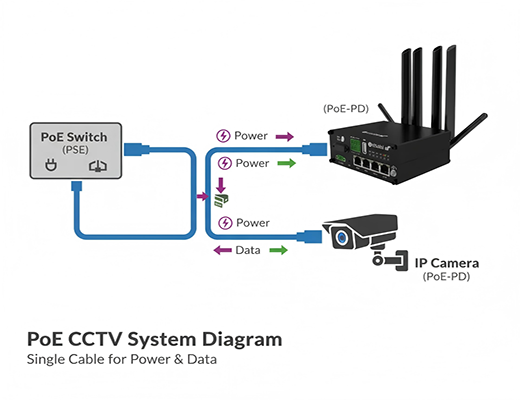
PoE-PD: Power Your CCTV & IoT with a Single Cable
|
|
Time to read 4 min
|
|
Time to read 4 min
When deploying a CCTV camera or an industrial IoT device in a remote or difficult-to-reach location, the biggest challenge isn't the data—it's the power. This is where PoE-PD (Powered Device) comes in.
Unlike traditional setups that require separate data and power cables, a PoE-PD device receives both through a single Ethernet cable from a Power Sourcing Equipment (PSE).
This technology isn't just a convenience; it's a strategic solution that drastically cuts installation costs, simplifies your network, and enhances the reliability of your surveillance and IoT systems.
In my years of working with remote deployments, I've seen countless projects get held up by the most basic of problems: how do you get power to a device? Whether it’s a CCTV camera mounted on a utility pole or a smart sensor installed deep inside a warehouse, finding a power outlet is often an unexpected logistical and financial headache.
I've watched teams spend days running expensive electrical conduit, only to realize later that a simple, single-cable solution could have done the job. That solution is Power over Ethernet, and at its core is a simple but critical concept: the PoE-PD. In my experience, understanding the difference between a Power Sourcing Equipment (PSE) and a PoE-PD is the key to unlocking a truly efficient and scalable network.
A PoE network is defined by the relationship between a Power Sourcing Equipment (PSE) and a Powered Device (PD). It’s a simple two-part system: the provider and the consumer.
A crucial safety feature is the detection handshake. Before sending any power, a PSE checks for a specific electrical signature to ensure the connected device is a legitimate PD and won't be damaged by the power surge. This ensures that you can safely connect a PoE-PD device without worrying about damaging it.
Deploying a CCTV system, especially for large-scale security or surveillance applications, is ripe for the advantages that PoE-PD offers. Here's why this technology is a game-changer for your projects.
The benefits of PoE-PD extend far beyond security and surveillance. In the world of industrial IoT, devices must be tough, reliable, and easy to deploy. A PoE-PD-enabled industrial router, like the R1520 Global, provides a single point of connection for both power and data.
A2: No. A regular network switch does not provide power. You must use a PoE-enabled switch or a PoE injector to supply power to a PoE-PD device.
A2: You must check the power standards and the device’s power consumption. A PoE-PD device that requires more power than the PSE can provide will not function correctly. For example, a camera might need 802.3at (PoE+), and your switch only supports 802.3af (standard PoE).Always check the specifications to ensure compatibility.
A3: Yes, absolutely. That’s the entire point of a PoE-PSE device. A PoE-PSE router can act as a local power source, transmitting power and data to a PD device, such as an IP camera, simplifying your deployment and extending the reach of your network.


